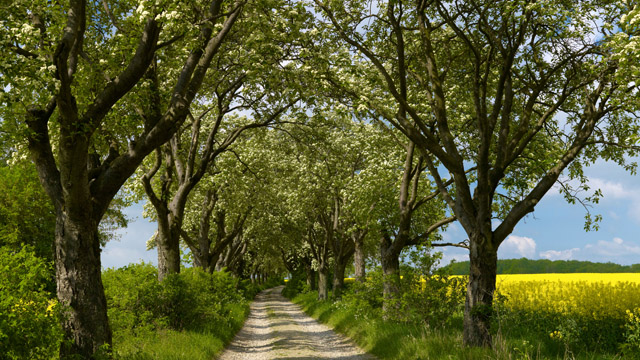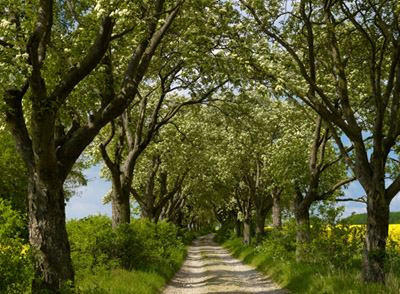The importance of planting trees
Trees are a great barometer of the seasons, and add so much to any garden, whether you can just plant one of a forest of them


I cherish the advice given many years ago by a landowner delivering a lecture to members of the RHS: ‘No matter how small your garden,' he declared, ‘always be sure to devote at least four acres to woodland.'
It is an instruction many of us would like to follow and some of us are lucky enough to be able to boast considerably more than that. But, even if you can fit only one tree into your garden, by doing so, you will be ensuring that the years will come equipped with their own barometer of the seasons- a daily glance at your chosen arboreal treasure will tell you which way the wind is blowing and how strong it is, whether it's raining or not and whether it's spring, summer, autumn or winter.
And now, as we enter high summer, the humming of bees in the lime trees is a happy memory of June, to be filed along with recollections of the unusually generous profusion of cream and pink floral candles that decorated our horse-chestnut tree this spring. Now, the spiky fruits are fattening to be ready for the conker matches of autumn and I long for the leaves to hang on in there, even if they are showing signs of leaf spot.
Not to worry; I know that next spring, after the ‘sticky buds' have opened like green umbrellas, the pageant will begin all over again. Thank goodness for the seasons-the prospect of living in an unchanging tropical climate doesn't appeal one bit. But trees need to be planted with care; so often the wrong tree (usually too vigorous) has to be butchered or felled in its prime, before it can do any damage.
It's a heartbreaking moment, but one that can be avoided by simple homework. Purple trees should be planted with caution and sparingly. One copper or purple beech, strategically positioned in the landscape, especially in parkland, can be inspiring; several can be oppressive and lowering.

Whitebeam trees are as glorious as any magnolia when their leaves burst open
Better, in the main, to cherish the lightness of whitebeam- as glorious as any magnolia when its leaves burst open, goblet-like, along the branches in spring, before losing much of their down and blending seamlessly into the background. And in parkland, plant the cedar of Lebanon, Cedrus libani. You will never see it at maturity, but it's a fine and generous way of leaving your mark. I find myself, at this time of year, willing the fruits of rowan and whitebeam, hawthorn and crab apple to slow down in their ripening. They're rushing me headlong towards autumn and I'm not ready to go there yet. My memories of spring are still strong: waterfalls of may blossom as dense and foaming as I can remember, the pleated, lime-green leaves of hornbeam and the silky smooth, ridiculously fragile beech foliage unfurling along an avenue I planted eight years ago. I have planted New Horizon elm trees in the hope that my grandchildren might enjoy a sight of which my own children were deprived: the tall and elegant elm, so unique in shape and cherished in hill and dale. If I romanticise, it's only because trees lead me to do so.
Sign up for the Country Life Newsletter
Exquisite houses, the beauty of Nature, and how to get the most from your life, straight to your inbox.
And I shall keep on planting, to make sure that my grandchildren's children can gaze up into the branches of the ‘old lions' and marvel at Nature. It doesn't matter if they don't remember me, but they will, at least, be able to appreciate the shade and, perhaps, feel some sense of responsibility for the landscape they inherit.
* This article first appeared in Country Life magazine on July 2 2014
* Follow Country Life magazine on Twitter
Country Life is unlike any other magazine: the only glossy weekly on the newsstand and the only magazine that has been guest-edited by HRH The King not once, but twice. It is a celebration of modern rural life and all its diverse joys and pleasures — that was first published in Queen Victoria's Diamond Jubilee year. Our eclectic mixture of witty and informative content — from the most up-to-date property news and commentary and a coveted glimpse inside some of the UK's best houses and gardens, to gardening, the arts and interior design, written by experts in their field — still cannot be found in print or online, anywhere else.
-
 380 acres and 90 bedrooms on the £25m private island being sold by one of Britain's top music producers
380 acres and 90 bedrooms on the £25m private island being sold by one of Britain's top music producersStormzy, Rihanna and the Rolling Stones are just a part of the story at Osea Island, a dot on the map in the seas off Essex.
By Lotte Brundle
-
 'A delicious chance to step back in time and bask in the best of Britain': An insider's guide to The Season
'A delicious chance to step back in time and bask in the best of Britain': An insider's guide to The SeasonHere's how to navigate this summer's top events in style, from those who know best.
By Madeleine Silver